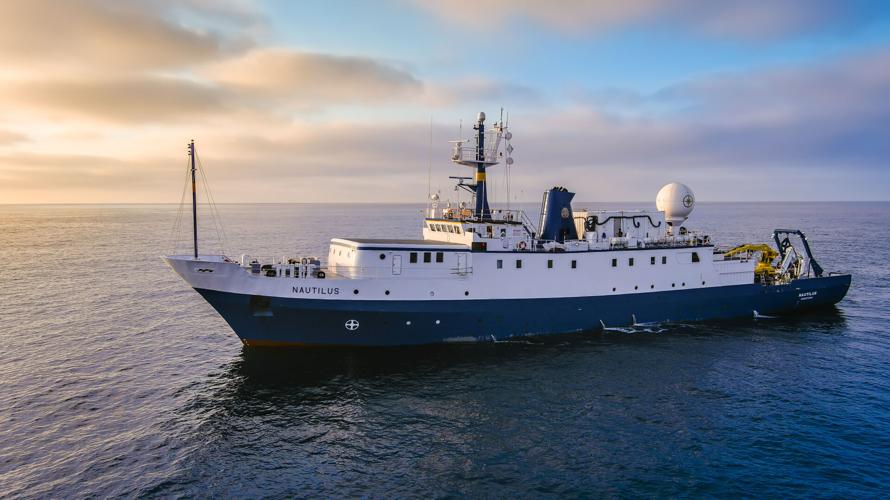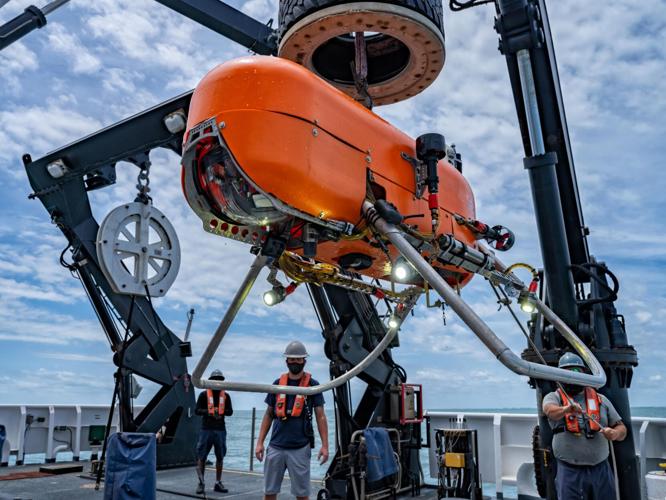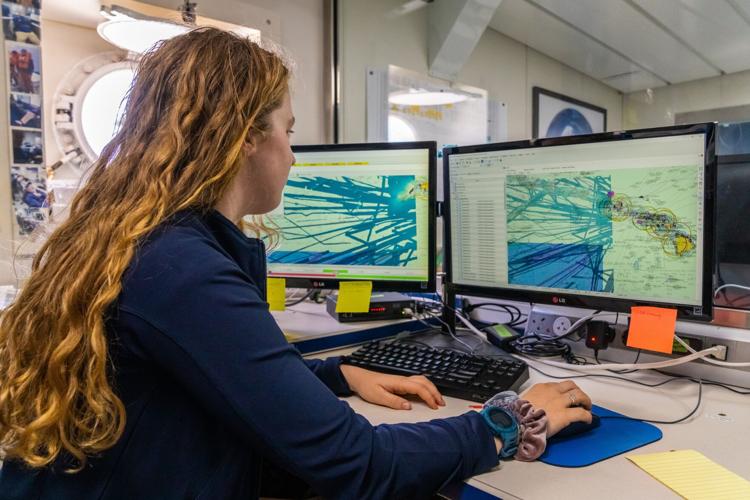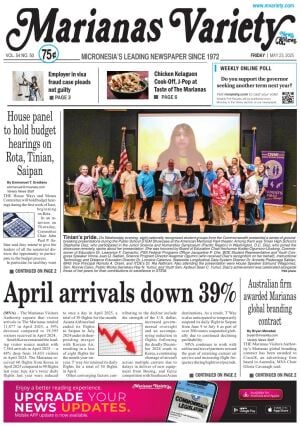APRA, Guam — On Wednesday, May 7, the Ocean Exploration Trust’s exploration vessel Nautilus set sail on its first expedition of 2025 to explore the ocean surrounding the Mariana Islands.
This region is largely shaped by the forces of plate tectonics, with some of the oldest seafloor on the planet being driven into the Mariana Trench (the deepest ocean trench) and then remelted to bubble up as magma, forming a chain of volcanic islands and subsea volcanoes.
West of the Mariana Islands, there are more than 60 underwater volcanoes and a complex back-arc spreading center where new seafloor is created.
Here, active hydrothermal vents support life in extreme conditions, where unique biology derives energy from the chemicals in vent fluids, rather than most life on Earth that relies on photosynthesis to thrive.
Using the remotely operated-vehicle or ROV Hercules and Orpheus Ocean’s Orpheus autonomous underwater vehicle, the team will explore deep-sea areas, including those prioritized by the local management and science community, including sites with signatures of active volcanism, abyssal plain habitats, and areas in and around the Mariana Trench Marine National Monument.
This 22-day expedition is supported by NOAA Ocean Exploration, the Bureau of Ocean Energy Management, and US Geological Survey via the Ocean Exploration Cooperative Institute.
“OET is thrilled to have the opportunity to collaborate with the local communities of the Mariana Islands on exploring the deep-sea wonders surrounding their islands,” said expedition leader and OET mapping manager Derek Sowers. “Our mapping systems will be able to detect changes in the seafloor due to recent seismic or volcanic activity, and we will use our deep-diving robots to reveal new discoveries at hard-to-reach hydrothermal vents, volcanoes, and other deep-sea ecosystems.”
The Mariana Arc is a chain of seamounts and islands, which are all active volcanoes. ROV Hercules exploration will be aimed at investigating active hydrothermal systems at some of the submarine volcanoes and the unique biological communities that live alongside them. Additionally, scientists hope to gain a better understanding of the recent geological history and potential geohazards of the region.
“The Mariana region is one of the most volcanically active places on Earth, but most of the action is underwater. E/V Nautilus will provide us with the technologies needed to explore these exciting, dynamic sites on the seafloor,” said Bill Chadwick of Oregon State University.
Sailing onboard E/V Nautilus for the first time will be the Orpheus AUV, built and operated by Orpheus Ocean. The Orpheus AUV will allow the team to explore the abyssal seafloor at depths up to 6,000 meters, which has to date been virtually unexplored around the Mariana Islands. During missions, Orpheus AUV will operate near or on the seafloor, performing high-resolution camera surveys as well as water and seafloor sampling.
“The Orpheus Ocean team is honored to contribute to this important exploration work in the Mariana region alongside the OECI. This expedition is perfectly aligned with our mission to provide scalable methods of access to the world’s most challenging and unknown subsea environments, and will serve as a key early demonstration of our technology’s capabilities and reliability,” said Jake Russell, CEO of Orpheus Ocean.
Joining the Corps of Exploration for this expedition are local educators, students, scientists, and resource managers from Guam and the Commonwealth of the Northern Mariana Islands. Ocean Exploration Trust is committed to building connections with local communities in expedition regions through co-developing expedition plans, making data publicly accessible, and coordinating outreach with schools and community groups.
The E/V Nautilus expedition to the Mariana Islands is just the beginning of an exciting 2025 field season, which will also include explorations around the Solomon Islands, the Marshall Islands, and Wake Atoll.
Five 2025 expeditions will build ocean knowledge supporting international scientific and U.S. governmental priorities, particularly understanding the deep sea, sharing that knowledge with others, and contributing new discoveries and data to inform future resource management decisions. Like this one, future expeditions are co-developed with national exploration priorities and input from scientists, resource managers, and local community stakeholders in the regions where the expeditions will take place.
Through the open sharing of data collected during these expeditions, we will build upon decades of study, stewardship, and discoveries. Mapping and ROV operations will directly contribute to the U.S. National Strategy for Ocean Mapping, Exploration, and Characterization, the Beyond the Blue: Illuminating the Pacific campaign, and other coordinated initiatives. The integration of different technologies into operations on E/V Nautilus continues to advance national priorities for increasing the efficiency and sophistication of ocean exploration.
From May to September 2025, E/V Nautilus expeditions will be streamed live on NautilusLive.org, a 24-hour platform that brings ocean exploration directly to viewers on shore. Telepresence technology allows viewers to engage with the team at sea, asking questions and receiving real-time behind-the-scenes updates via social media. Classrooms worldwide are invited to connect with the at-sea team of STEAM professionals via free educational Q&A interactions. Additionally, OET offers free educational resources for K-12 learners in English, Spanish, Palauan, Samoan, and ʻŌlelo Hawaiʻi, including national-standard aligned activities, engineering design challenges, and creative projects for learners in the classroom or at home.
As E/V Nautilus operates in the Western Pacific, OET recognizes and respects the deep cultural connections many have to this region. OET's expeditions are planned in consultation with local communities to ensure mutual respect and collaboration. We welcome partnership inquiries at info@oet.org/.
About the Ocean Exploration Trust
The Ocean Exploration Trust was founded in 2007 by Dr. Robert Ballard to explore the ocean, seeking out multi-disciplinary discoveries while pushing the boundaries of STEM education and technological innovation. Its international program is launched from aboard the E/V Nautilus, offering live exploration to participants on shore and the public via live video, audio, and data feeds.
The 2025 E/V Nautilus expeditions are sponsored by NOAA Ocean Exploration via the Ocean Exploration Cooperative Institute, including additional support from the Bureau of Ocean Energy Management, in collaboration with the U.S. Geological Survey. OET program sponsors and partners for 2025 also include the Office of Naval Research, QPS, and the Phillip Stephenson Foundation.

















